Economics and geography students put their research and data skills to work on behalf of Zanesville, presenting options for redevelopment and the economic impact of the Mosaic Tile Property to the City Council on April 23.
The economics students analyzed the economic impact, and the urban planning students developed possible redevelopment options.
WHIZ News reported on the project in a story headlined “OU students present Brownfield Redevelopment project to Council.”
The project, in partnership with the City of Zanesville, is looking to develop sites in South Zanesville. Jay Bennett, the Public Service Director, said the students from the geography and economics classes have been working on the redevelopment plans.
“For the last couple of months they have been focusing on the Mosaic site. Doing the analysis. Looking at reports. Interviews. Talking to people,” said Bennett. “Understanding what’s happening with housing, economics, infrastructure, recreation, amenities, jobs. So they’ve kind of done all of that, and it’s fun watching the two different departments.”
“It’s been fun watching the two departments” work on the projects, Bennett adds.

Jessica Dalzell, geography graduate student, presents the group’s findings to the mayor and City Council of Zanesville.
The geography students are in a new urban planning studio course. “It is a real-world project-based course where students apply what they have learned in the classroom.” says Dr. Amy Lynch, Assistant Professor of Geography who is teaching GEOG 4900/5900. Eleven undergraduates and three graduate students participated in the studio course. Lucas Rhyan ’18, an environmental geography undergrad, and graduate student Jessica Dalzell presented on behalf of the class. (See Rhyan presenting at the end of the WHIZ video.)
Students in ECON 4150 Regional Analysis class “conducted two analyses to estimate the economic impact of the brownfield site and estimate the likely outcomes of redevelopment,” says Dr. Tia McDonald, Assistant Professor of Economics. Her class had 13 undergraduate Economics and Business majors as well as one graduate student.
A brownfield site is one that had previous industrial or commercial uses.
Economic Impact of Redevelopment
To estimate the economic impact of the brownfield site, the students conducted a hedonic analysis—a regression analysis used in economics to determine how variables affect price—that estimated the negative impact of the site on housing prices.
“They found that the closer you live to the site, the lower your housing value (not surprising) and that the total impact of the site was around $1.2 million,” McDonald said. “This provides a baseline for the City of Zanesville in terms of predicting the effect of redevelopment on housing prices and property tax revenues.”
To estimate other possible effects of redevelopment, the students identified a city with a successful brownfield redevelopment that was demographically similar to Zanesville. They chose to examine the city of Johnstown, Pa.
“They used a difference-in-difference model to estimate the causal effects of the redevelopment on incomes, employment, labor force participation and the number of renters in the area,” McDonald says. “They found that the redevelopment resulted in an increase in around 900 jobs for the area. They also found that redevelopment increased the unemployment rate. These two findings seem to be at odds except that the students also found an increase in labor force participation. I would interpret these findings as both the number of jobs and the number of people looking for jobs increased as a result of redevelopment, which shows an increase in economic optimism, something economically depressed areas have in short supply.”
“My main goal for this class was to provide the students with some analytical tools that they could apply in a real world setting,” McDonald says. “The job market seems to be rewarding students who have data skills, and this was an attempt to show the students how powerful these skills can be.”
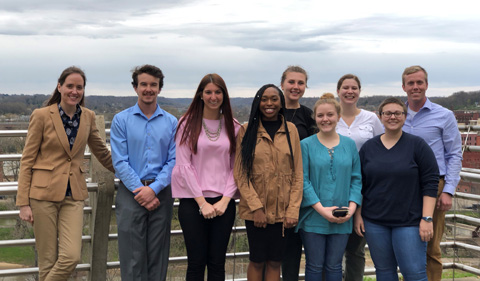
Dr. Amy Lynch with geography graduate and undergraduate students who attended the site visit and presentation to the Zanesville City Council.
Urban Planning Options
“Over the course of the semester, we have been working with the Community Development Department of Zanesville to examine the possible redevelopment of a large brownfield site in a residential neighborhood. The students have collected data on the neighborhood and site, analyzed the data, and come up several potential uses that would meet the needs of residents.
“The students used the U.S. Census, a pre-existing community survey, a third-party economic analysis, and interviews with stakeholders to identify nine viable uses of the site and some flexible uses that could complement whatever the future developer chooses. Notably, the site is huge (18.5 acres), so it will undoubtedly be used for a combination of things,” notes Lynch.
“The students’ role was to think about what could be, not to determine what will be. That will be up to the city, local community, and developers. We just wanted to give them something to think about. Several of the students’ ideas, like a food truck gathering space or indoor recreation in the form of a trampoline park or laser tag were not uses the city had previously considered. To the extent that we were able to push thinking about what the site could be, we were successful,” she says.
“The purpose of our class was essentially to produce a report for the City of Zanesville that outlined our analysis of the Mosaic Tile brownfield site and our predictions of what form of redevelopment would work well at the site and for the community,” says grad student Dalzell. “The class was split into three groups to perform a majority of the work for this project. Each of the groups had about five people who were assigned different roles to complete a cohesive report at the end of the semester.
“We all had different assigned tasks and collaboratively worked to create an abundant amount of information and a large deliverable end product,” said Rhyan. “This was a fairly accurate representation of how a team would work in a large planning studio in the workforce, and it was a great opportunity to practice working in this scenario. I would say that this experience—especially to have it as an undergrad—is probably one of the best collaborative opportunities I have had. Additionally it feels great to be apart of something that has a direct and positive impact on a community.”
“The most difficult aspect of this project,” Dalzell adds, “was trying to predict uses that will benefit a community that we had never visited. It is difficult to decide what people need when we were not in direct contact with the persons of this neighborhood. I have always been really interested in revitalization and redevelopment within cities, so this project allowed me to expand on those interests. I am focusing my master’s degree on urban planning, so this project provided relevant experience for a future career.”
“Jay Bennett, the Community Development Director for Zanesville, invited us to present our initial findings to the mayor and City Council and has been an incredible community partner,” Lynch notes.
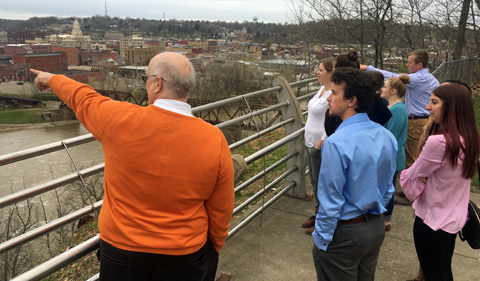
Zanesville Community Development Director Jay Bennett speaks with geography students about the city.
The next step in the process will be a community survey, likely to go out this summer, which the Regional Analysis students can analyze in the future.


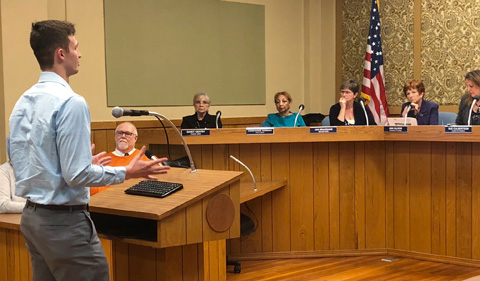

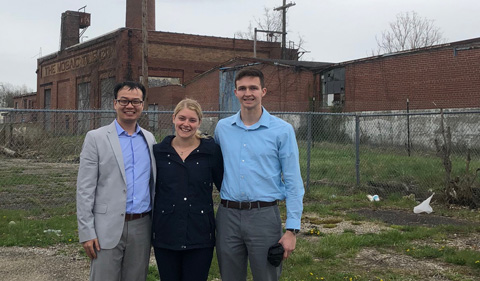
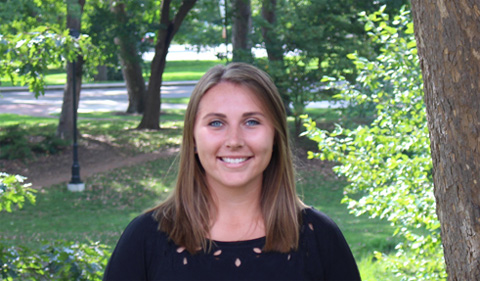
















Comments